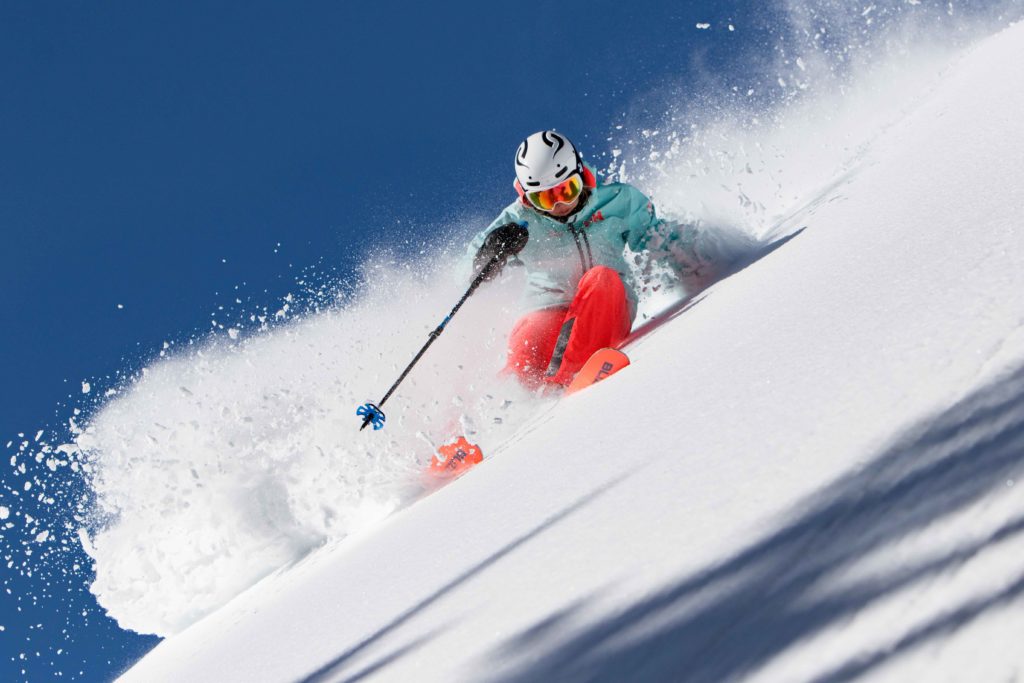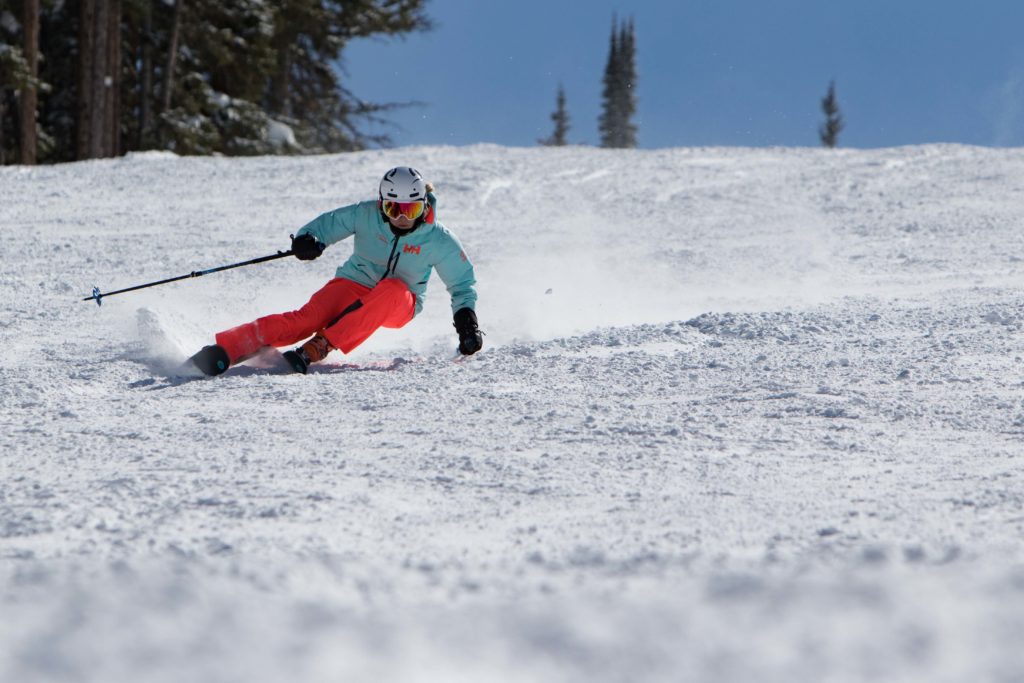In 1993, there were 25 models of reputedly made-for-women skis entered in the Snow Country Magazine ski test. They were classified as “recreational,” but a more accurate adjective would have been “dreadful.” Not a single brand of the 18 represented was aiming at anyone above average ability. Our elite test crew regarded them with unvarnished contempt.
The reason no one tried to concoct a decent women’s model was the prevailing attitude among ski makers that making a model specifically for good women skiers was a misbegotten enterprise. The men who designed skis were, of course, skiers themselves, and the women they skied with didn’t ask for or want anything to do with a “women’s ski.” Nonetheless, the selection of women’s skis continued to grow, soon adding a cadre of step-up, “performance” models that were still three rungs below the nearest race ski in any brand’s collection.
Solid technical skills translate beautifully to powder, regardless of gender. Photo courtesy of Blizzard.
I share this historical nugget as it establishes a baseline that in some aspects still exists today. Now as then, the best female skiers in the world are racers, an arena in which made-for-women skis simply do not exist. A hefty percentage of non-racing experts also prefer either a unisex ski or women’s ski that’s a virtual clone of a unisex model.
But unlike the situation 30 years ago, made-for-women models are no longer an exercise in condescension. Outside of the race world, they occupy every category and price point in the ski pantheon. The mind-blowing success of Blizzard’s Black Pearl 88 has firmly established the viability of the made-for-women market. Just how much any given women’s model has actually been adapted for the fairer sex is another matter, one this essay – and companion chart – intends to illuminate.
With your permission, I’m going to burn two minutes of your attention span by chatting about the attached chart (below). It’s a nearly complete list of the women’s models offered in the U.S. in 2020. For each model, it indicates what changes, if any, were made in comparison to any corresponding unisex model. Four design elements are examined: construction, materials, mounting position and sidecut. A model with “X’s” across the board has been built from scratch to be a women’s ski. Gray scale in lieu of an X means that this ski shares that feature with a unisex model.
The one trait that all women’s models share is they come in shorter lengths. It’s common practice to pare down the core thickness on shorter skis so the intended, lighter weight target skier can bend it. Because thinning the core profile is standard operating procedure that applies to any short ski, regardless of who it’s sold to or how the topskin is decorated, this modification is treated as a given and so doesn’t appear on this table. The same can be said for changes in sidecut geometry that are related to length, not gender per se.
What the table tells us is that most of the X’s land on Technical and Frontside models and most of the gray scale spans across the All-Mountain East, All-Mountain West and Big Mountain genres. Among modifications, moving the mounting point forward (normally in the 1-2cm range) is by far the most common accommodation for women. As for more consequential alterations, changing a sidecut – and therefore the tooling – is less likely an adaptation than employing a modified construction and/or a switch in materials.
What the chart doesn’t reveal is how much time and money each brand spends sorting through all the alternatives that might make a ski better for a lighter weight skier. Salomon, for example, maintains separate test crews for system skis and flat (wider) models, yet their testing often leads them to propose identical solutions for men and women. Nor does the chart cast any light on any given brand’s future direction.
But the chart is clear on one point about the present: there are a lot of checked boxes and a lot of gray scale boxes, which exposes a schism in the current thinking about women’s skis. On one side of the philosophical divide, empirically derived differentiation is deemed both good for the female skier and for the company that commits to it.
The other side of the argument hasn’t changed since the days of the Snow Country ski test: the ski can’t tell a good female skier from a good male skier, so why do women need different skis? If you want to adapt a model or two specifically for women who need training wheels, fine, but don’t try to help skiers who neither need nor want any help.
Great technique looks good in any terrain. Photo courtesy of Blizzard.
Both of these perspectives are here to stay, as is the abundance of choices available across the women’s market as a whole. If there’s a category that could use shoring up, it’s Women’s Frontside, for which I have a simple, economical solution.
Instead of isolating the best, most adapted, hard-snow women’s skis in the Technical genre that Americans eschew, make clones of the flagship women’s model in 80mm and 84mm waists. I don’t suggest anyone eliminate their current crop of diluted Frontside models that match the needs of intermediates, just add one or two strong skis geared for the advanced gal. They won’t attract a lot of American women right away, perhaps, but it would be a step in the right direction. As things stand, American women are more or less obliged to “graduate” to an All-Mountain East model just to get a high performance women’s ski.
Most likely the market for high performance, Frontside women’s skis will remain small, but maybe not. Nobody saw the Black Pearl 88 coming, not even Blizzard. And it’s been the top selling ski in America, regardless of gender affiliation, for the past four seasons.


